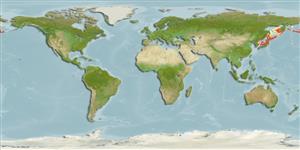Elasmobranchii (Haie und Rochen) (sharks and rays) >
Rajiformes (Skates and rays) >
Arhynchobatidae (Softnose skates)
Etymology: Bathyraja: Greek, bathys = deep + Latin, raja, -ae = a ray (Raja sp) (Ref. 45335); smirnovi: Named for 'Mr. Smirnov', Inspector of Fishes, who collected fishes from the Sea of Okhotsk (Ref. 89865).
Environment: milieu / climate zone / depth range / distribution range
Ökologie
seewasser demersal; tiefenbereich 100 - 1000 m. Temperate; - 36°N (Ref. 89865)
North Pacific: Sea of Okhotsk, Kuril Islands, and the Sea of Japan.
Size / Gewicht / Alter
Maturity: Lm ? range ? - ? cm
Max length : 102 cm TL Männchen/unbestimmt; (Ref. 89865)
Kurzbeschreibung
Morphologie | Morphometrie
This species is distinguished by the following characters: no blotches on the dorsal disc surface or a pair of white or dark blotches; dark blotch and band usually absent on the ventral disc surface; predorsal caudal vertebrae 80-87 (Ref. 123274)..
Geographical variations are present in the populations of the seas of Japan and Okhotsk: number of total tail thorns, ranging from 21-33 (average and standard deviation: 27.3±2.9) (southern Sea of Japan) vs.19-29 (26.0 ± 2.3) (northern Sea of Japan), vs. 22-27 (24.3 ± 1.5) (Sea of Okhotsk) (P < 0.05) and the frequency distribution of tail thorn numbers was bimodal in the Sea of Japan [modes: 25 and 28,29 (southern); 25,26 and 28 (northern)], but unimodal in the Sea of Okhotsk (mode: 25) (Ref. 123274).
Oviparous. Distinct pairing with embrace. Young may tend to follow large objects, such as their mother (Ref. 205). Eggs are oblong capsules with stiff pointed horns at the corners deposited in sandy or muddy flats (Ref. 205). Egg capsules are 12.4-15.0 cm long and 8.7-9.0 cm wide (Ref. 41249, 41253). Depth range given by H. Ishihara (pers.comm. 07/07). Reported to feed primarily on amphipods, decapods, fishes, euphausids, and squid on Yamato Bank in the Sea of Japan. Maximum length reported 116 cm TL (Ref, 89865).
Life cycle and mating behavior
Geschlechtsreife | Fortpflanzung | Ablaichen | Eier | Fecundity | Larven
Oviparous, paired eggs are laid. Embryos feed solely on yolk (Ref. 50449). Distinct pairing with embrace. Young may tend to follow large objects, such as their mother (Ref. 205). Eggs have horn-like projections on the shell (Ref. 205).
Misawa, R., A.M. Orlov, S.Y. Orlova, I.I. Gordeev, H. Ishihara, T. Hamatsu, Y. Ueda, K. Fujiwara, H. Endo and Y. Kai, 2020. Bathyraja (Arctoraja) sexoculata sp. nov., a new softnose skate (Rajiformes: Arhynchobatidae) from Simushir Island, Kuril Islands (western North Pacific), with special reference to geographic variations in Bathyraja (Arctoraja) smirnovi. Zootaxa 4861(4):515-543. (Ref. 123274)
IUCN Rote Liste Status (Ref. 130435)
Bedrohung für Menschen
Harmless
Nutzung durch Menschen
Mehr Information
Alter/GrößeWachstumLänge-GewichtLänge-LängeLängenhäufigkeitenMorphometrieMorphologieLarvenLarven Pop.Dyn.RekrutierungDichteBRUVS
ReferenzenAquakulturAquakultur ProfilZuchtlinienGenetikElectrophoresesVererbbarkeitKrankheitenVerarbeitungNutrientsMass conversion
PartnerBilderStamps, Coins Misc.LauteCiguateraGeschwindigkeitSchwimmstilKiemenoberflächeOtolithsGehirngrößeSehfähigkeit
Tools
Zusatzinformationen
Download XML
Internet Quellen
Estimates based on models
Preferred temperature (Ref.
123201): 0.6 - 3.8, mean 1.6 °C (based on 122 cells).
Phylogenetic diversity index (Ref.
82804): PD
50 = 0.5000 [Uniqueness, from 0.5 = low to 2.0 = high].
Bayesian length-weight: a=0.00513 (0.00253 - 0.01042), b=3.12 (2.95 - 3.29), in cm total length, based on LWR estimates for this Genus-body shape (Ref.
93245).
Trophic level (Ref.
69278): 4.0 ±0.7 se; based on size and trophs of closest relatives
Widerstandsfähigkeit (Ref.
120179): niedrig, Verdopplung der Population dauert 4,5 - 14 Jahre. (Fec assumed to be <100).
Fishing Vulnerability (Ref.
59153): High vulnerability (61 of 100).
